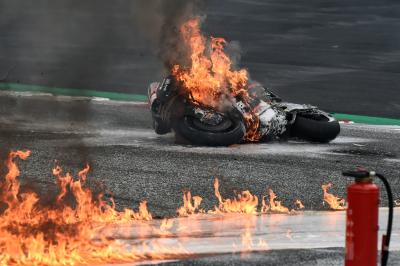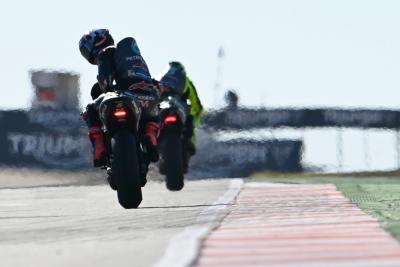Rider down: MotoGP's future accident-detection system
In the aftermath of tragic accidents for teenage riders in junior classes this season, falling and being hit by following competitors, new safety regulations have targeted changes in three areas: Entry List Sizes and Age Limits, Rider Equipment and Rider Communication.
While the reduction in some grid sizes and raising of age limits are self-explanatory, whatever the advances in rider equipment it's sadly not possible to fully protect against a direct impact from a motorcycle at high speed.
The best that can probably be done in such situations is to try and warn following riders as soon as possible, increasing their chances of successful evasive action.
That's what the 'Rider Communication' part aims to address.
Aside from the tragedies on smaller machines, MotoGP had a near miss when Dani Pedrosa fell from his KTM on the third lap in Austria with his bike then being hit by Lorenzo Savadori (pictured).
Pedrosa was in twelfth place when he fell, with roughly five-seconds then passing before Savadori (in 21st) ploughed into the unsighted machine. Pedrosa was unharmed, but Savadori suffered ankle fractures in the fiery impact, which stopped the race.
While some multi-rider incidents take place in a split second, the lengthy time between Pedrosa's fall and Savadori's subsequent impact underlined that the present 'human' warning system, which relies on following riders either seeing an incident ahead or spotting yellow flags and flashing signal boards controlled by nearby marshals, is not enough.
The new target is to create 'automatic, near-instant warning systems for all following riders/motorcycles' with the first tests starting 'as soon as the beginning of the 2022 season'.
Such systems wouldn't help in every situation, but might give a vital 0.5s-5s of extra warning where following riders are unsighted to an incident ahead, perhaps while cornering, riding over the crest of a hill and/or due to a group of competitors obscuring their view.
With the new season now less than three months away, exact details of the proposed system remain under wraps.
A test involving the use of rear rain lights during dry conditions, as a possible method of alerting riders of an accident ahead (by flashing), took place during Friday MotoGP practice in Portimao.
Riders reported the lights remained visible even in bright sunshine, although the varying location on each machine meant some were easier to spot than others and Crash.net understands the method of warning riders of an accident remains to be decided.
But the first issue to solve is how an accident will be detected in the first place.
Use of the word 'automatic' means without human input. In other words, detecting a loss of control using sensors rather than relying on a trackside marshal or official in Race Direction to press a button.
Airbag systems, compulsory in all classes, already contain mathematical algorithms that have been honed to reliably predict at the earliest possible moment when a rider is falling.
Earlier this year, before plans for the automatic system were announced, Alpinestars confirmed to Crash.net the possibility of using airbag deployment as the trigger for some kind of automatic warning system. So if an airbag goes off, riders in that area would receive an alert.
But a company spokesman added that the need to make the system universal across all bikes and riders means it would probably be easier to develop, implement and control using bike-mounted technology.
The advantage of bike-mounted sensors is that the system would trigger even in small accidents where an airbag would not deploy and could perhaps also cover incidents such as a rider running wide into the gravel. Any additional weight for the detection equipment would also not be an issue.
Crash.net has been told that is indeed the current line of investigation for the new MotoGP-designed warning method, the aim of which is to use an onboard system to automatically detect and communicate an accident.
Exactly which kinds of sensors will be used is not known. The most basic would simply be lean angle: If the bike is on its side, an accident has occurred. The technology is already used to shut an engine off to avoid damage if a bike is on its side.
But with every tenth of a second crucial in such multi-rider incidents, waiting for a bike to stay on its side might take too long and it's likely that lean angle would be one of several inputs used (rider inputs, speed sensors and suspension travel could be among the others).
Just as when airbags were being developed, plenty of track testing (initially during free practice) will be needed to gather enough data on the fine line between alerting as quickly as possible and sending a 'false positive'.
The good news is that, unlike with incorrect airbag deployment or a false dashboard message such as 'black flag' or 'pit', any early glitches in the automatic system should not ruin a rider's race.
The rider may back off for an instant, but it would soon be clear if there has actually been an accident ahead or not and the system could 'reset' after ten seconds or so.
It would also do no real harm if the automatic system was a little too sensitive and reacted to a 'loss of control', even if a rider didn't actually fall.
For example, someone having a big tank-slapper might trigger the accident warning system for following riders, even if the rider ahead then regains control. But the warning itself should mean following riders keep clear, helping prevent a potential tangle should the rider ahead swerve unpredictably.
But the accident detection and then warning method are probably not the biggest technical hurdles.
The current dashboard messaging system is only one-way, meaning signals pass from Race Direction to the motorcycles.
The new automatic warning system will require modifying the trackside communication infrastructure so that a signal can be transmitted from the fallen bike either directly to other machines and/or via a nearby marshal post or Race Direction.
The whole thing must also be simple enough to set-up and operate outside of MotoGP events, the criteria given for the new system stating it will be 'applicable to Championships of all levels, including Talent Cups'.




![Johann Zarco, LCR, Honda RC213V, 2024 San Marino MotoGP, Misano, action [Gold & Goose]](https://cdn.crash.net/styles/thumbnail/s3/2024-09/GnG_1166323_HiRes.jpg?itok=vpgrU7Q4)

![Jack Miller, KTM Factory Racing, KTM RC16, San Marino MotoGP, Misano, action [Gold & Goose]](https://cdn.crash.net/styles/thumbnail/s3/2024-09/GnG_1167624_HiRes.jpg?itok=iz7mA4EQ)


![Fabio Quartararo, Monster Energy Yamaha Racing, Yamaha M1, 2024 MotoGP, Misano Test, action [Gold & Goose]](https://cdn.crash.net/styles/thumbnail/s3/2024-09/GnG_1168928_HiRes.jpg?itok=fcYSole_)
![Toprak Razgatlioglu, ROKiT BMW Motorrad, BMW M 1000 RR, Magny-Cours, WorldSBK [Gold & Goose]](https://cdn.crash.net/styles/thumbnail/s3/2024-09/GnG_1165133_HiRes.jpg?itok=GD5SVNVG)

